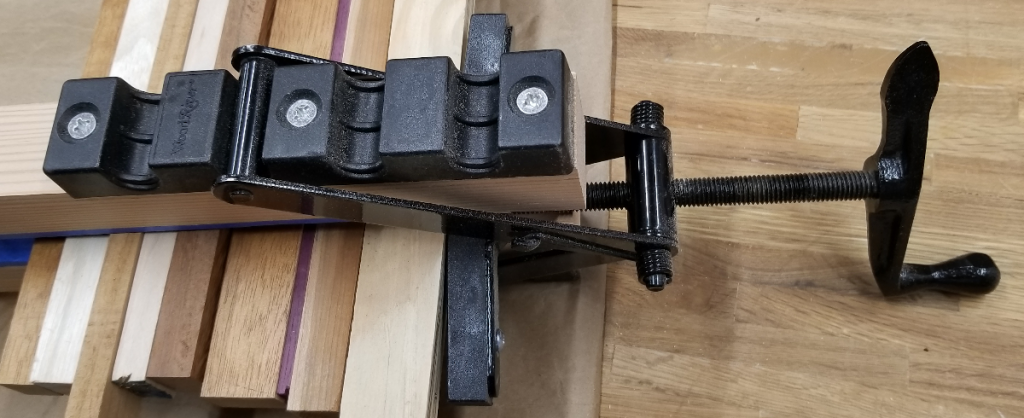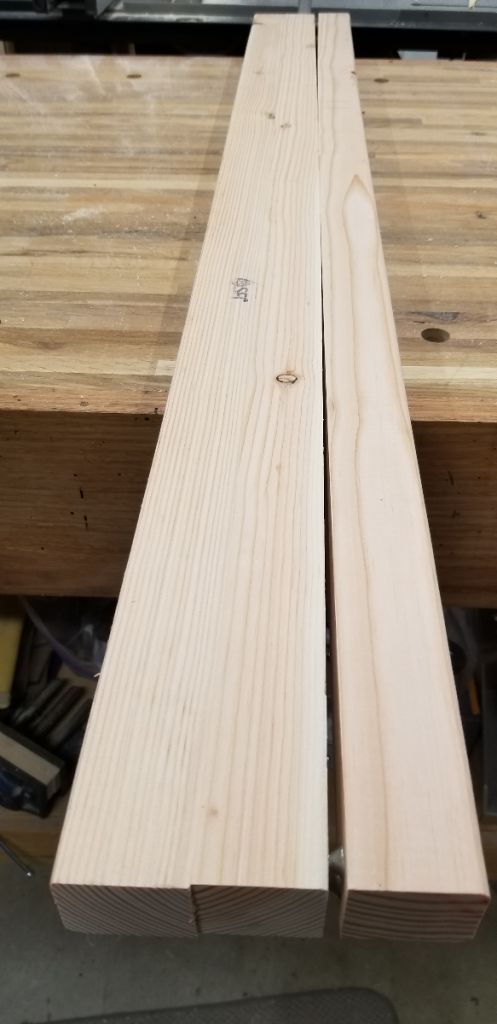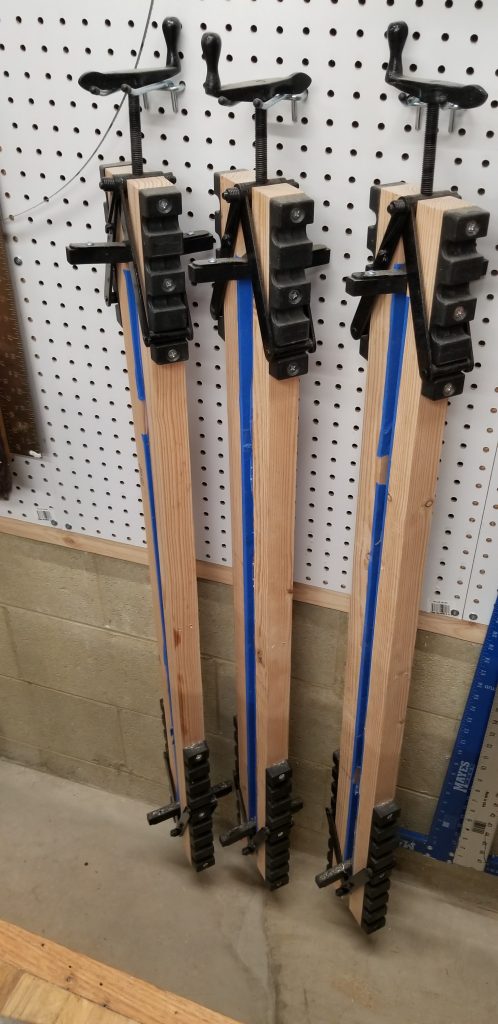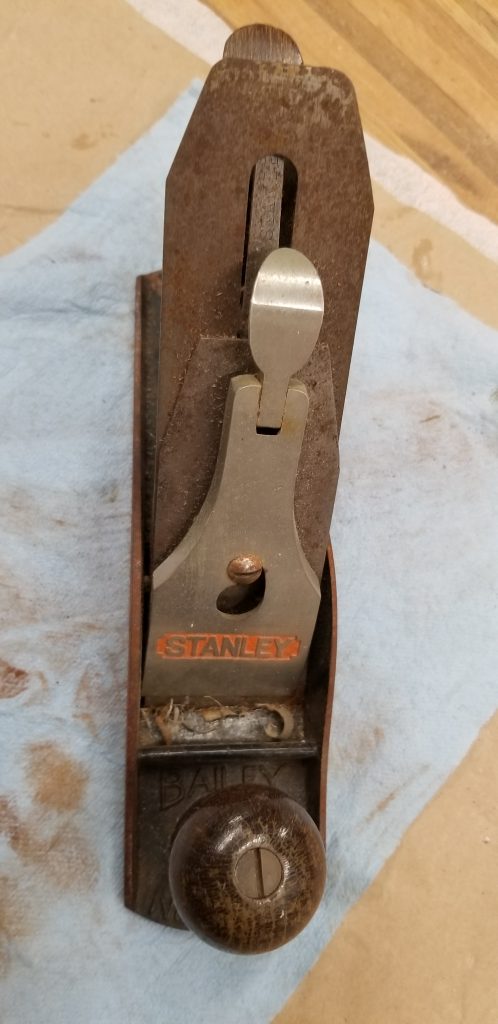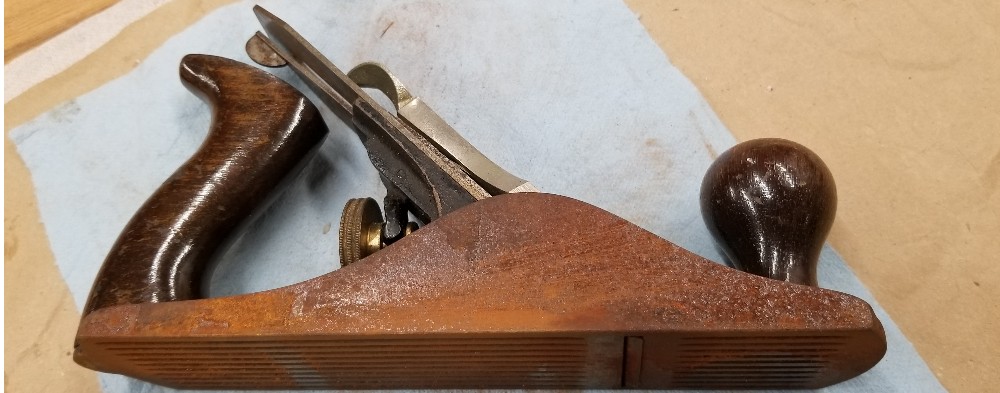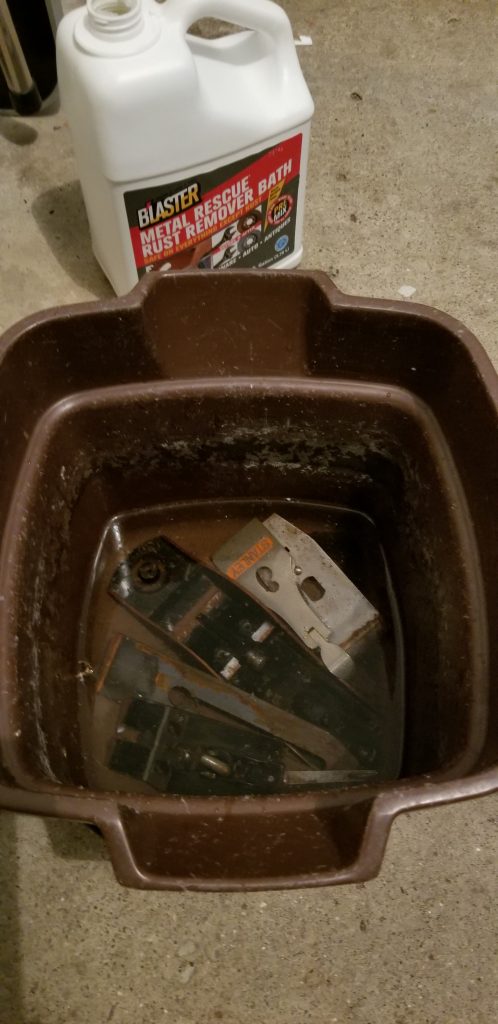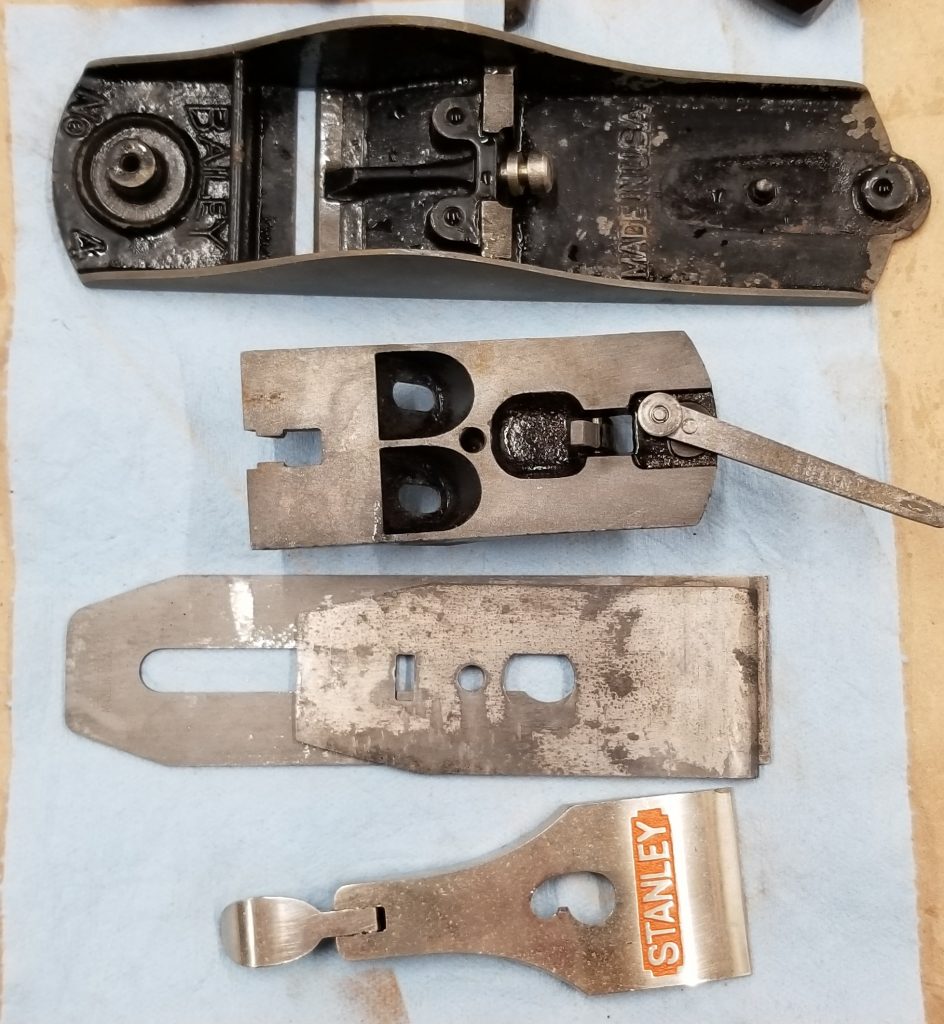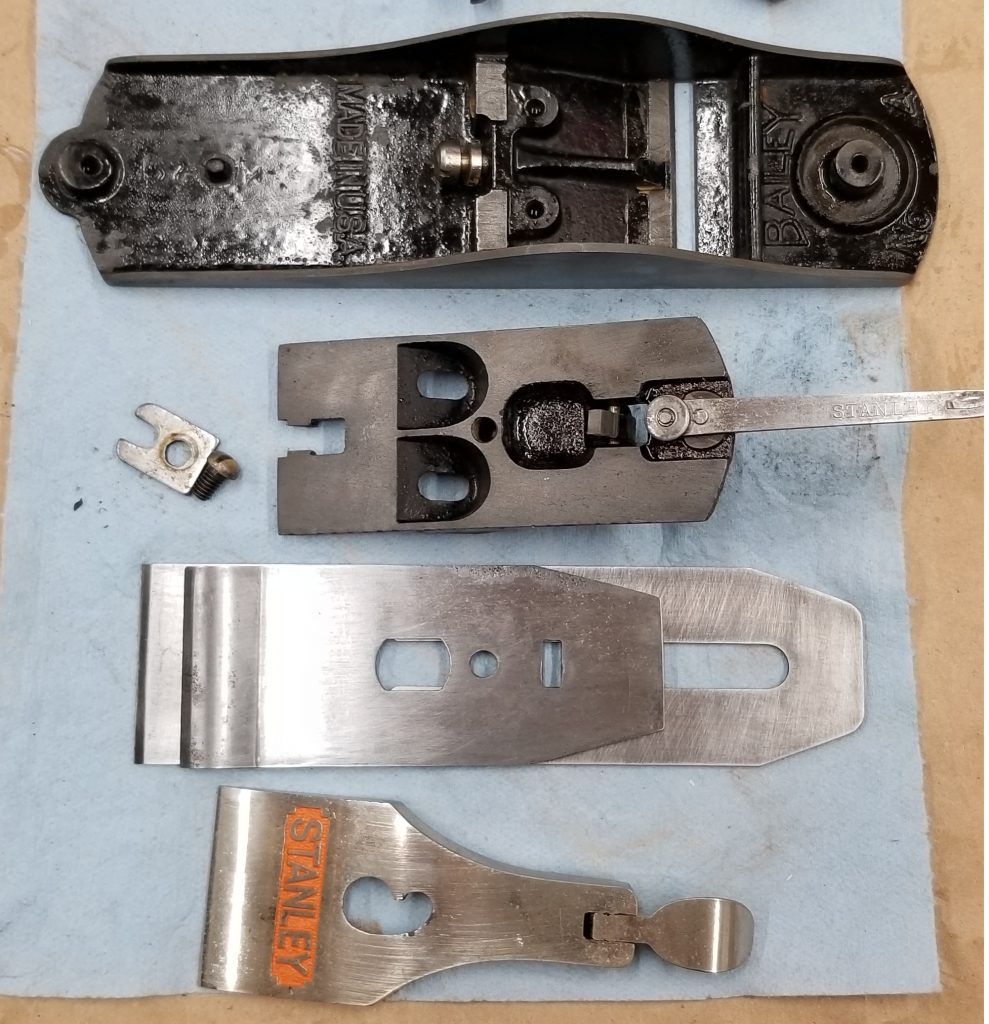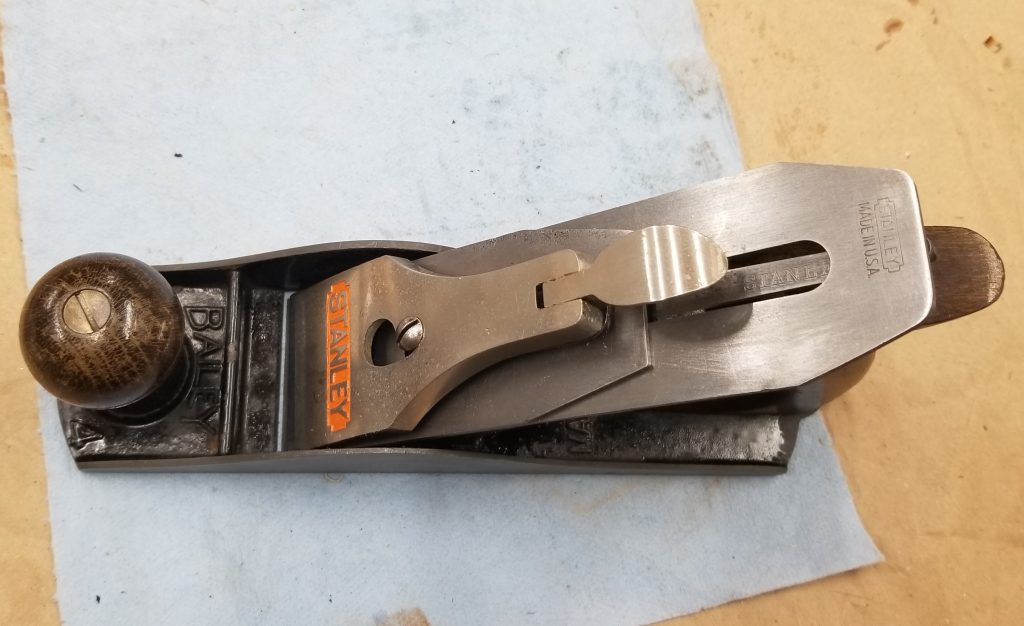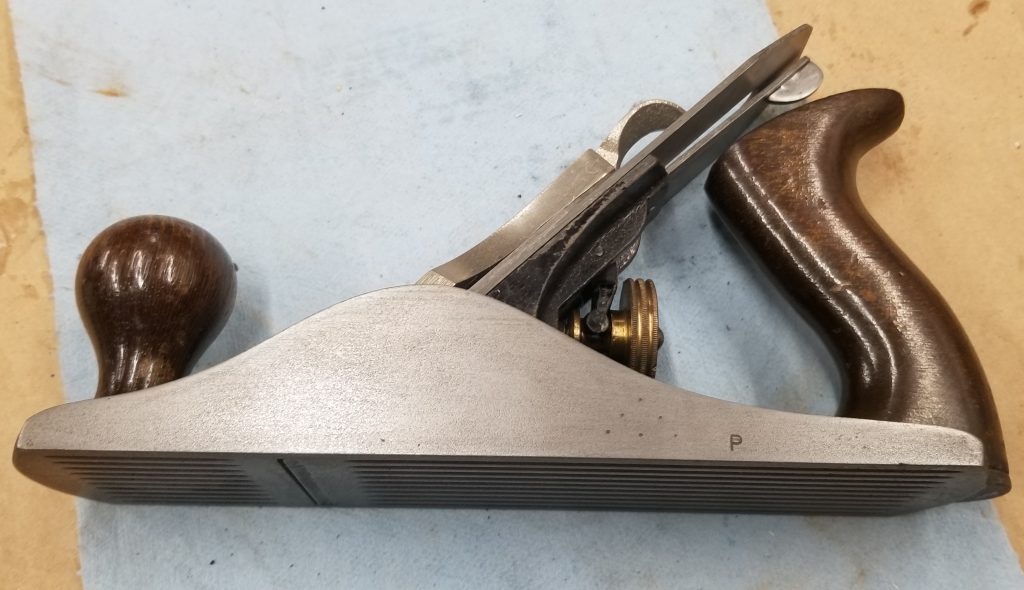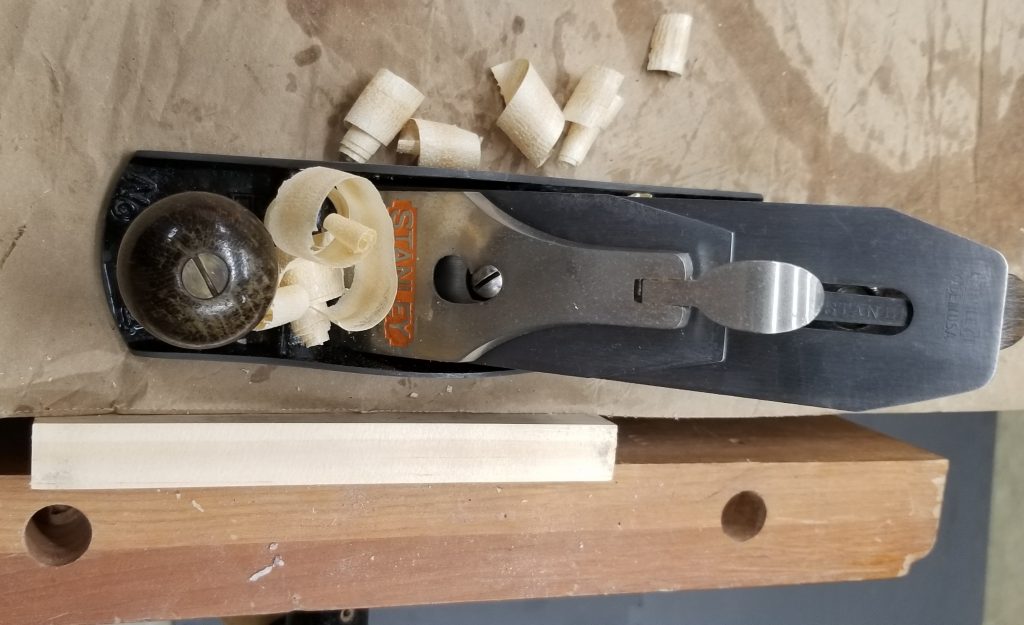We have a Leisure Travel Van (LTV) Unity RV. Love it. But there is always something you can do to personalize, customize, or upgrade an RV. In this case, it is the dining area table top
Note: This post is part description of what I did and part advice on how to do something similar if you are so inclined. All of the measurements can be adjusted to whatever suits your project.
The Unity came with a functional table top that was about 24″ square and had two leaves that folded out from the top to give about 39″ width. It fits well between the seats and can be used with the leaves out or not. But there were a few things that led me make changes.
The Table Leg
The table is mounted on a fixed post between the seats. Even with the leaves folded up, it was inconvenient to go from the van driving or passenger seat into the back ‘house’ area.
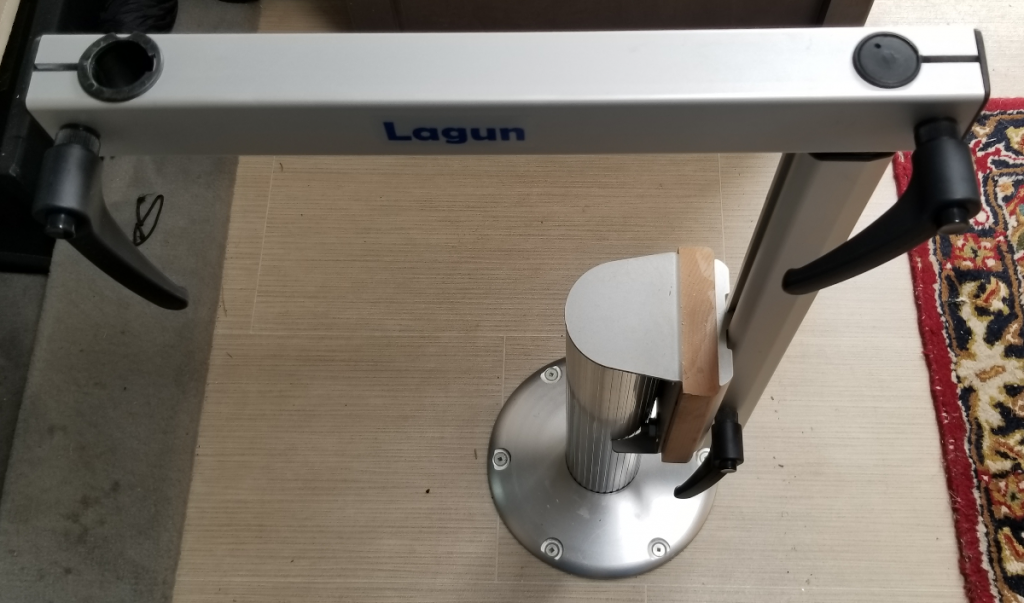
So the first change was to install a Lagun leg. This is an articulated post arm that lets you rotate the top and swing it over to the side.
That solved the access problem.
Side note: This is a Lagun brand leg. LTV now provides their own version customized to their purpose. With the Lagun leg, the position of the table top ends up slightly more forward than desired. My solution was to insert a 1″ block of wood between the post mount and the Lagun leg mount. Good enough.
The Table Top
That was fine for a while but a few things about the top bugged me.
- Because the leaves folded out from the top and rested on simple hinges, they developed a droop. Not huge but enough that the surface wasn’t flat.
- If you were using the table with the leaves folded up, and then decided to open the leaves, you had to remove everything from the table, open the leaves, and put everything back.
- The top was made of particle board with a laminated surface. Unsurprisingly, over time it began to show chipping on the edges.
- Also because of the laminated particle board, the edges were square. That gets annoying and even painful if you are resting your wrists on the edge.
So… Time to make a new top.
These are the basic design requirements for the new top.
- Dimensions to be similar to original table top. Roughly 24×24″ closed and 24×39″ open. Finished thickness of 11/16″.
- Weight to be no more than original table top.
- Construction to use real wood. No laminates, plywood, particle board, etc.
- Leaves that fold under so that they can be opened without disturbing what is already on the table.
- Leaves must not droop when opened. (Not when new and not over time.)
- All edges to be softened (rounded) for comfort.
- Must mount on the existing Lagun leg.
- Oh, and it should look appealing.
The Build
I am a fan of laying up multiple strips of wood to form a panel. Not only do I like the look of it, but
- I don’t have to find, and work with, 24′ wide slabs of wood, and
- the resulting panel resists warping and cracking.
Diagram
Here is a drawing of the general layout. The main top part of the table will be the area between the “cut lines”. The parts outside the cuts are the leaves.
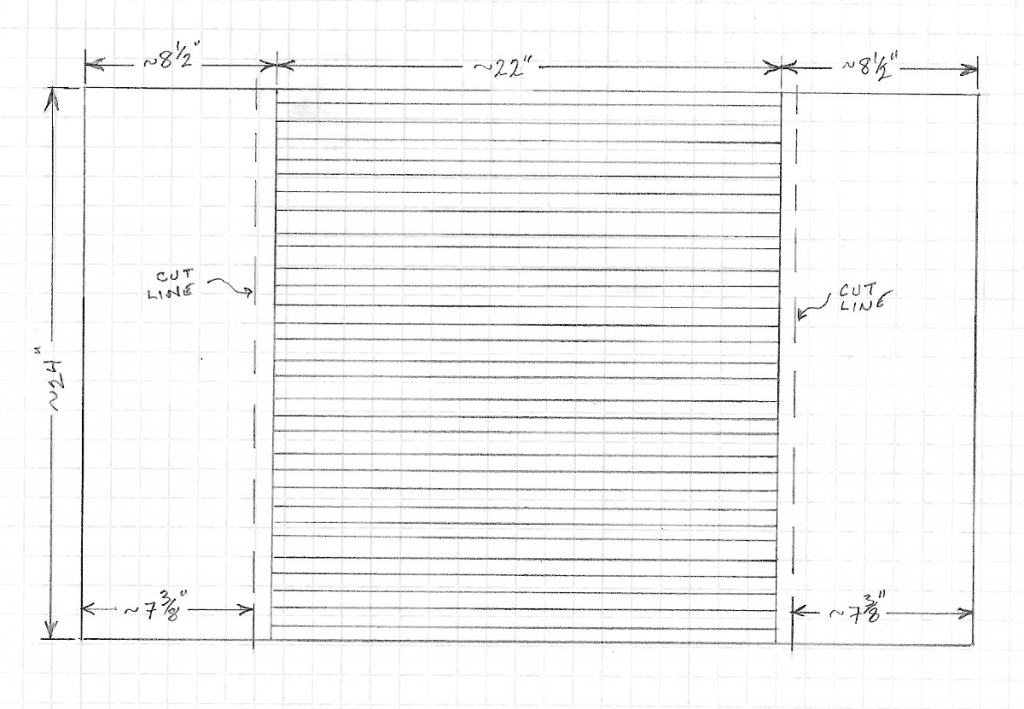
Note that all dimensions are approximate. You want the table top to be about 24″ square when closed up and about 24″ x 39″ when opened. A half inch here or there isn’t going to make much difference.
Step 1: Select the Woods.
They should be all relatively hard woods to handle the wear and tear of a kitchen table. I’ve used a variety of woods that were lying around the shop: mahogany, oak, maple, and walnut. Plus one board purchased for the leaves which will be solid to maintain strength both in the leaf and at the joint.
Be sure to have your design consultant with you at this stage. I’m good with the engineering and construction but not so hot on colors and finish elements. The fact that the top looks so good is entirely down to my wife. She has an eye for this. I don’t.
Step 2: Prepare the Wood Strips
The strips of wood vary from about 3/4″ to 1-5/8″ width and are planed to roughly 1″ thickness. They must be planed or jointed to be co-planar to ensure a tight fit between them with no visible gaps. If they do not sit tightly together before being glued, there will eventually be cracks formed between them.
These strips form the main part of the table. They should be at least 24″ long to allow for trimming to final size of 21-3/4″. There must be enough of them to achieve the full table top width of 24″. I recommend making the outermost strips from the same board used to make the leaves. This adds a nice border effect to the top.
At least two of the strips should be closer to 30″ long. These will be protection against snipe when planing the panel.
Step 3: Initial Panel Glue-up
Unless you have a 24″ or wider plane, you will need to glue up two or more panels that will later be glued together. My plane can handle 12-1/2″ so I went with two panels.
For each panel, I used my 24″ panel clamps. (See this post for more info on panel clamps.) I glued up the strips for one half of the table top, inserted extra boards on the outside edges to spread the pressure, and clamped them tight. Note that I placed one longer strip in each, as mentioned earlier, to fight snipe.
After giving it overnight to cure, I did the same again for the other half. I could have done both halves in my larger clamps but gluing and positioning that many strips is pushing the limit of initial drying time.
Step 4: Preparing the Leaves
I rough cut the wood for the leaves to slightly more than the final dimensions. So, about 30″ long by 9″ wide. I then planed it to about 1″ thick–similar to the initial thickness of the strips for the main part of the table. It is important to prepare the leaves at this stage because all the pieces must be planed together in the next step.
Step 5: Thickness Planing
After using a chisel to remove most of the glue squeeze out, it was off to the plane to set the thickness.
I planed the wood down in small increments: initially 1/32″, later 1/64″. I rotated through both glued-up panels and both leaves. At each pass I turned the boards over so that both sides benefited from planing. Once the thickness was down to 11/16″, it was done.
Step 6: Main Top Panel
We still have two ~12″ panels for the main top and it is time to glue them together.
For this step, I converted my 24″ clamps to 48″ clamps. (These clamps have a slight bow in them to ensure pressure in the center where these two panels will meet.)
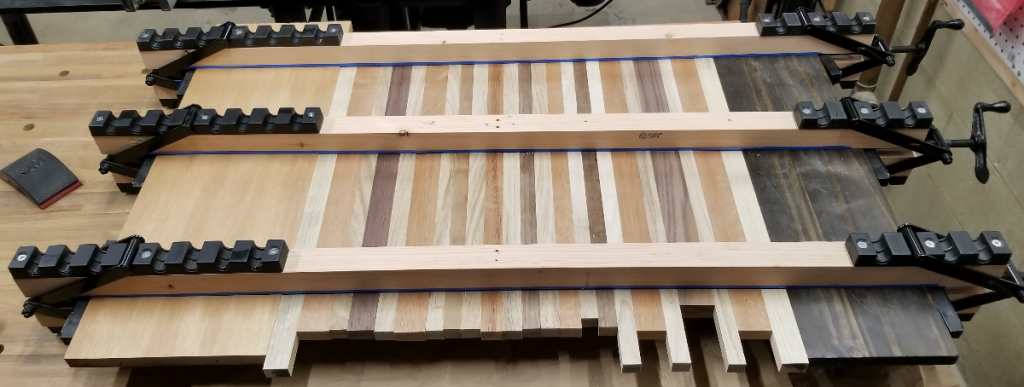
Using two wide boards on the outside to spread pressure and protect the work pieces, the two halves are glued and aligned as closely as possible. A rubber hammer helped to tap the center to get the joint completely aligned. Then it’s another overnight wait for the glue to set.
After removing the clamps, the center strip is cleaned of glue squeeze out and sanded to remove any remaining misalignment or glue marks. Getting this joint right is why it is important to plane the pieces together and to be meticulous about the alignment in the glue-up.
Step 7: Trim the Top
Now that the top is built, cut it to size. The ends of the strips will be various uneven lengths and have to be cut square and clean to allow for attaching the leaves. Using the table saw, I cut the ends off on each side to get a final width of 21-3/4″.
Step 8: Attach the Leaves
At this point, the leaves do not have hinges and haven’t been shaped. They are also probably slightly bigger than final size. Trim the width of the leaves so that the total width of the leaves plus main top comes to 39″.
Now is the time to attach the boards. So, back to the long clamps. Glue up the leaves to the outside of the main top with the main top rotated 90 degrees so that the ends of the strips are glued to the leaves.
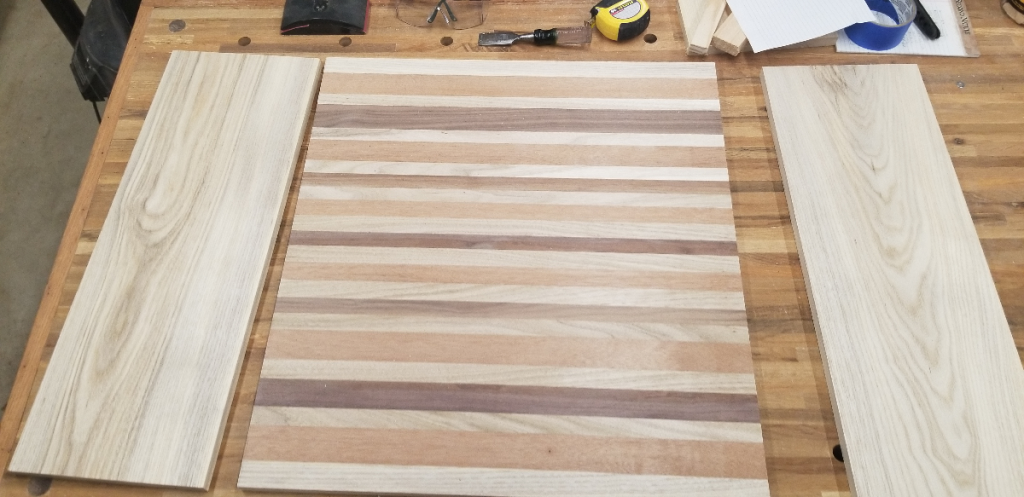
Take all the same care as previously and let it set up overnight. Once set, clean up the glued joints and sand as needed.
Step 9: Cutting the Leaves
Before cutting the leaves loose from the top, carefully trim the ends of the leaves to match the width of the top. The boards for the leaves were originally cut extra long to allow for snipe protection. The final size should be made in this step.
The finished size of the leaves should be about 7-3/8″. Measuring in from the outer edge and cutting, this will leave about a 1″ piece of the leaf board attached to the main top. This provides a nice border effect to the top. It also provides strength to the ends of the strips that will need to hold the hinges.
Step 10: Prepare for the Hinges
Oh yes, did I mention the hinges? To get leaves that fold up from the bottom and make a stable flat surface, you need special hinges. You want the hinges used by restaurants to convert a square table into a larger round table. I found these in two sizes. As usual on Amazon, there are multiple vendors selling the same hinges. The larger size has the advantage of a clip that holds the hinge closed when the leaf is under the table. But it is large and very heavy. The smaller one is perhaps half the weight and, sadly, doesn’t have that clip. But the smaller one–at about 6″ when opened as in the picture–is the right choice.
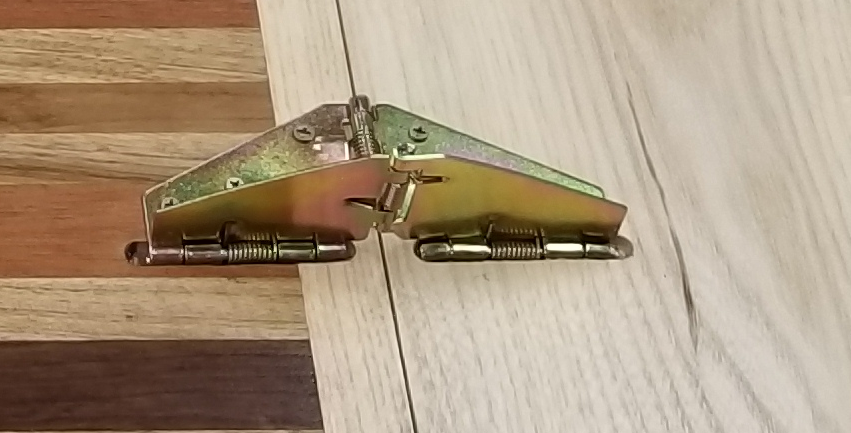
The hinge mechanism requires a groove to be cut in the wood so that the wings can lie flat. Align the main top and the leaves as they will be when finally assembled. Determine hinge location and mark it across the length of the hinge. Mark the length of the needed groove on both the top and the leaf.
(The folding part of the hinge must be on the joint between the leaf and the top. How far in from the side is a balance. Too far apart and they may allow the center of the leaf to dip. Too close together and you will have trouble reaching under the table to close the hinge.)
Use your favorite tool to create grooves that the hinge can sit in. I made a jig and used a 1/4″ round nose router bit to make the grooves. Do not try to router it freehand.
Do not install the hinges yet.
Step 11: Rounding the Corners and Edges
Choose an appropriate radius and round the corners of the main table top and the leaves using a band saw, jig saw, or whatever works for you.
Using a router and a small round-over bit, round off the top edges or the main table top and both leaves. (A 1/4″ bit worked for me but size it to the hinge you have.) Next, round off the bottom edges of these pieces BUT do not round off the bottom off the joints between the main table top and the leaves. Those edges can be eased a small amount with sanding.
Step 12: Test Assembly
At this point, you can confirm the hinge placement and ensure that everything will fit properly. If you install the hinges, don’t tighten the screws fully and don’t exercise the hinge. This is just making sure the fit is right.
Step 13: Sanding and Finish
Sand all surfaces until smooth. Sand the corners and round-overs as needed to clean up any issues from rounding the corners and to get a smooth feel.
The choice of finish is up to you. I used a water-based, satin finish polyurethane. I usually like to go with tung oil or other natural finishes. But this is going to have to stand up to spills, sunlight, etc.
Step 14: Final Assembly
After you finish the finish, install the hinges fully and test that they work as expected. Install the Lagun leg mount–or whatever mounting system you are using. In my case, it goes in the center at one edge of the top. Your mileage may vary.
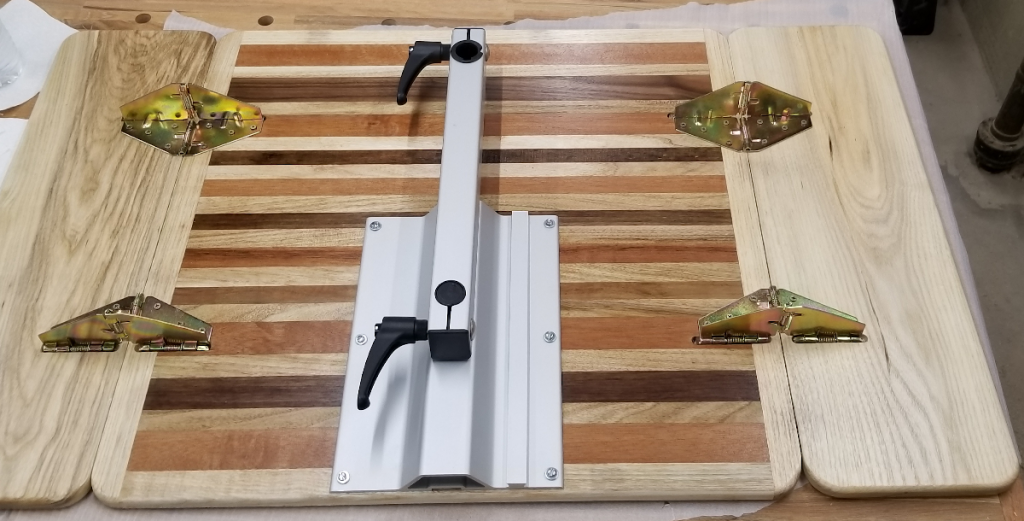
NOTE: Be sure to mount the hinges with the screws toward the middle and the raised part toward the outside edge. You will close the leaves by reaching under the top and pulling on the hinges.
Step 15: Install It
Well, that does it. Not a quick project but the results are so worth it.
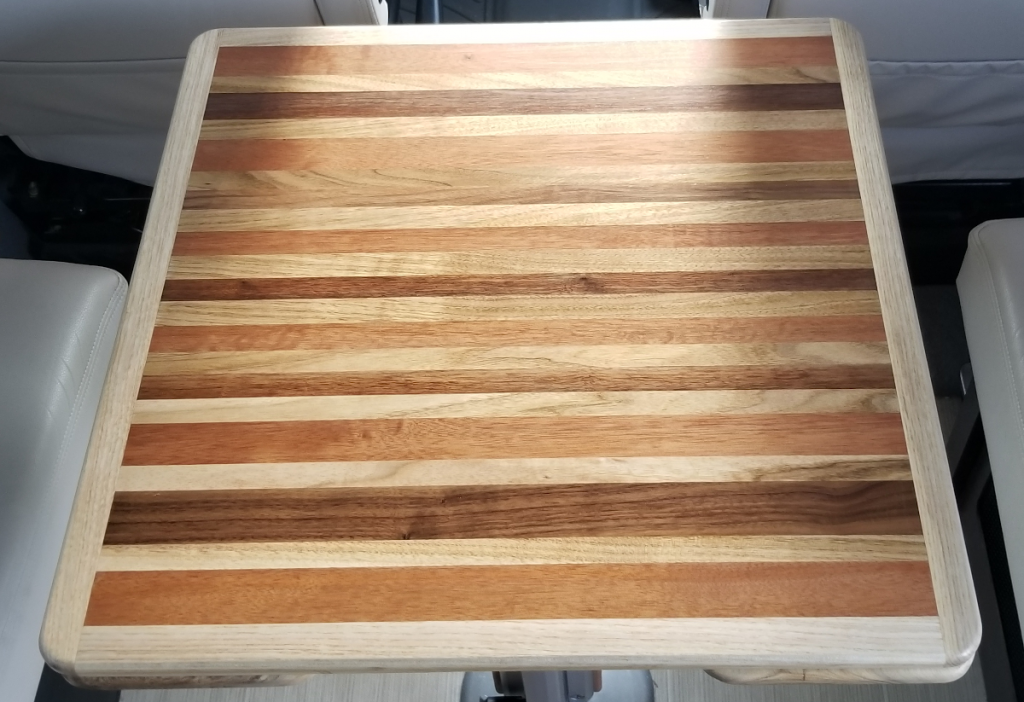
A Final Note
Because the hinges don’t have a clip to keep them closed when the leaves are down–as in the photo above–the leaves do wobble a bit on bumpy roads. This is a minor annoyance. If I come up with a good solution, I will update this post.

